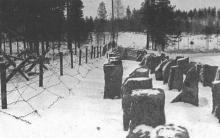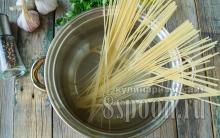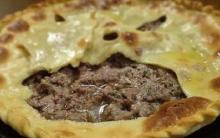Making stew at home is not as difficult as you might think from the very beginning. However, it should be noted that many housewives prefer to use only fresh meat to prepare family dinners. And this is not surprising. Although there are also situations when you can’t do without stew. It is for such cases that we recommend stocking up on prepared meat for future use.
Step-by-step recipe for homemade pork stew
This type of meat is most often used to make homemade stew. This is due to the fact that the mentioned product contains a large amount of fat, which allows you to prepare a very nourishing and juicy preparation. So, to prepare pork stew we will need:
- white pork lard - approximately 280 g;
- pork shoulder - about 1 kg;
- bay leaf - a few leaves;
- ground allspice and fine iodized salt - use to taste.
Main product processing
Stew at home is prepared very quickly and easily. First, you should wash the pork shoulder well, clean it of all kinds of veins, wreaths, etc., and then cut it into medium pieces. After this, the meat ingredient must be seasoned with pepper and salt, then mixed well and kept aside for several hours.

Forming and heat treatment
As a rule, stew at home is made in 750 g or half-liter glass jars. While the meat is marinating, they should be washed well and then sterilized by any known method. After all the described steps, you need to put one bay leaf in each jar, and then tightly place the pieces of pork. Next, all containers need to be covered with sterilized lids and placed in a cold oven. After turning on the oven, preheat it to a temperature of 240 degrees and bring the meat in the jar to a boil. Next, reduce the heat to 140 units and cook the dish for 3 hours. While the pork is being thermally processed, the white lard must be rinsed in cold water, then cut into small pieces and fried over low heat. The melted fat must be separated from the cracklings and drained into a separate bowl.
Conservation process
After the meat has stood in the oven for 3 hours, all jars should be removed, poured with melted fat and immediately rolled up. After leaving the workpieces at room temperature, you should wait until they cool down. It is advisable to store meat in jars in a cool place for no longer than 8-12 months.
Making poultry stew
As you can see, stewing at home is quite easy to do. However, it can be prepared not only from pork, but also from chicken. To do this you need to prepare:

- chicken legs - about 1.6 kg;
- chilled chicken fillet - approximately 1 kg;
- salt, bay leaf, black peppercorns - use to taste.
Meat preparation
To make chicken stew at home tender and tasty, the meat should be properly prepared for heat treatment. To do this, you need to wash it, remove all the bones, cartilage and skin, and then cut it into fairly large pieces. Next, the processed product should be seasoned with salt and kept in the refrigerator for about an hour.
Form and cook on the stove
Preparing homemade poultry stew involves using only sterilized 750 g or liter jars. In them you need to put two bay leaves, as well as a few peas of allspice. Next, you need to distribute the chicken pieces among the containers, compacting them tightly. After this, the jars should be loosely closed and placed in a wide basin, the bottom of which should preferably be lined with a kitchen towel. In order for the stew to cook well, you need to pour enough water into a large bowl so that it covers the container up to the hanger. Next, you need to bring the liquid to a boil, reduce the heat and cook for 5 hours. In this case, it is necessary to constantly ensure that the water in the basin remains at the same level. This can be achieved by adding it in the required quantity.

Seaming process
After 5 hours, the chicken stew should be completely cooked. It must be carefully removed from the basin and rolled up with sterilized lids while still hot. Having turned the containers upside down, it is advisable to keep them in this position for about a day. Next, the cooled stew should be removed to a cool room, where it is advisable to store it for no more than 6-8 months. If you decide to leave a canned meat product at room temperature, it is recommended that it be completely consumed within 3-4 months.
How to make beef stew at home?
This preparation is most popular among lovers of canned foods. This is due to the fact that it turns out very tasty, satisfying and aromatic. Moreover, the fat content and calorie content of such a preparation can be easily controlled by adding or excluding lard. So, in order to prepare your own beef stew at home, you need to prepare the following products:

Beef processing
What needs to be done to make beef stew very tasty and aromatic? Firstly, you should purchase only the freshest meat possible. It shouldn't be frozen. Although fresh meat will not work. In this regard, it is recommended to buy only chilled product. Before you start processing beef (thermal), you need to rinse it thoroughly in cool water, and then cut off all unnecessary and inedible elements. After this, you need to chop the piece of meat into small cubes, place them in a deep bowl, add salt, mix thoroughly and leave covered in the refrigerator for 30-50 minutes.
Heat treatment process
After the chilled meat has released its juice, it should be placed on low heat and, stirring regularly, brought to a boil. At the same time, it is highly not recommended to add additional water or broth to the pan. Beef should be stewed in its own juices. This process may take you about 4-5 hours. If you feel that all the moisture from the dishes has evaporated, then you should add a small amount of chopped lard to the meat. To finish off the ingredients, you need to add a few bay leaves and allspice.
Final stage
After the beef has been stewed well in its own juices, it should be salted, distributed into sterilized jars and filled with the lard that has accumulated in the pan. Next, the containers must be sealed and left to cool. When all the jars have cooled down, they should be immediately put into a cold room, where it is advisable to store them for no more than six months.

How to use in cooking?
Beef, chicken or pork stew can be used to prepare completely different dishes. For example, pasta, potatoes and other vegetables with meat come out very tasty from this preparation. Moreover, some housewives make rich soup using stewed meat. If you take a jar of stew on a hike, then you can eat it just like that (for example, along with fresh bread), but preheat it over a fire.
Stew is rightfully considered a universal dish. You can take it with you on a hike or eat it in combination with side dishes. Salads are often prepared using canned meat. Of course, you can go to the store and buy the product you like, but many housewives prefer to cook the stew themselves. This is not surprising, since the end result is a completely natural composition from your favorite meat. Like any other business, cooking stew includes important aspects. Let's look at them in order.
Features of cooking stew
- Absolutely any meat is suitable for homemade stew. It could be chicken, lamb, rabbit, pork or even beaver and lamb.
- The cooking time directly depends on the type of meat chosen. For example, pork stew simmers longer than a product based on chicken or rabbit.
- Experienced housewives, through trial and error, developed their own technologies for preparing stew using an oven or multicooker.
- The main advantage of stew is the availability of components and available materials. To carry out the procedure, you will need meat pulp, sterilized small jars (0.4-1 l.), and a saucepan.
- If you prefer to eat pork, lamb, or beef stew, it is important to choose the right meat for preparing the product. Fresh fillets are considered the best option.
- You can use the cuttings on which everyone’s favorite goulash or azu is prepared. If you buy pork, make sure that the surface is covered with fat. Before cooking, this layer must be cut off.
- Rabbit stew is made from drumsticks, chicken stew is made from thighs. It is important to remember that stew is made only from chilled meat. Frozen raw materials cannot be used.
- As mentioned earlier, the stew is rolled into jars. The dishes must first be sterilized in a convenient way (water bath, oven). The same applies to lids; they can be tin or plastic.
- The stew is stored in a cool place without dampness, especially if it is covered with tin lids. If you follow the storage conditions and also roll the finished canned food into a sterile container, the stew will last for about 3 years.
- If lean meat is used to prepare the stew, the composition can be “diluted” with rendered lard in moderate quantities. This move will increase the shelf life and saturate the dish.
- Veal is not suitable for stew, since it is significantly inferior to beef in taste. Choose a large piece, which you will later cut yourself.
- If the meat is not mixed with water, the average cooking time is about 3-4 hours. It all depends on the volume and quantity of additional ingredients.
- Stew comes from the concept of “stewing”. For this procedure, thick-walled and thick-bottomed dishes with high sides are used. A cauldron is considered an ideal option.
- If the stew is sealed in containers with tin lids, grease the latter with melted lard. This move will prevent the formation of rust and increase the shelf life.
- During the cooking process, it is important to ensure that pieces of meat do not float to the surface. Stewing should be done in its own juice, the product will be more saturated.

- meat (pulp) - 3.5 kg.
- onions - 4 pcs.
- bay leaf - 12 pcs.
- salt - 40 gr.
- ground pepper (black) - 7 gr.
- Pass the onion through a meat grinder or chop it in a blender, mix with ground pepper and salt. Dip the pork pulp in water, dry it, and chop into medium-sized cubes.
- Mix the mixture, transfer to a food container and seal. Refrigerate for 30 minutes. If desired, you can add your favorite seasonings.
- When marinating meat, sterilize containers and lids. Distribute the bay leaf among the containers and add the pork. Boil filtered water and pour into jars not to the brim.
- Prepare a thick-bottomed pan. Line the bottom with a towel or place a wooden board. Place containers with stewed meat and cover with lids.
- Fill the pan with water, place over medium heat and bring until the first bubbles appear. When this happens, reduce the power to minimum and simmer for 4 hours.
- During the entire cooking stage, monitor the presence of water in the pan and add it if necessary. When the composition is ready, tighten the jars and turn them upside down.
- Wrap the container with the composition in a warm towel, leave at room temperature until completely cooled (about 12 hours). After this, move the stew to a cool place.
Pork head stew
- pork head - 1 pc.
- salt - 45 gr.
- ground black pepper - to taste
- peppercorns - 5 pcs.
- laurel - 7 pcs.
- Wash the meat, dry it and cut off the fatty layers (cheek). Remove bones and cartilage, rinse again. Chop the meat into cubes (size approximately 4*4 cm).
- Select a pan with thick walls and bottom and place the meat inside. Add water until the liquid covers the pork completely.
- When the mixture boils, reduce the power to minimum and simmer for 3.5 hours. About 45 minutes before final cooking, add bay leaf, peppercorns, ground pepper, and salt.
- Sterilize the jars in a convenient way and wipe dry. Place the finished stew into warm containers. Prepare a wide saucepan and line the bottom of the dish with a thick towel.
- Place the containers with meat inside, fill with water up to the beginning of the neck (up to the shoulders). Bring until bubbles appear, reduce heat, and simmer for another half hour.
- When the specified period has expired, remove the jars and immediately seal them with sterile lids. Turn the container over, make sure there are no leaks, and cool.

- meat - 2.5 kg.
- thyme branches - 2 pcs.
- drinking water - 100 ml.
- laurel - 5 pcs.
- ground black pepper - to taste
- salt - to taste
- Rinse the beef under the tap, dry with towels, and cut into large pieces. Prepare a bowl with a thick bottom and walls. A roasting pan is considered an ideal option; it produces meat that is aromatic and rich in flavor.
- Place the chopped pieces of beef in a stewing container, add water and stir. Cover with a lid, leave a small hole (about 1 cm). Place the roasting pan on low heat and simmer for 2.5 hours.
- It is important to stir periodically and check the composition for the presence of broth. If the liquid boils away, add it one tablespoon at a time. After the specified period, add salt, pepper, and thyme branches.
- Mix the mixture, cover with a lid and place a towel on top. Let it brew for 8 hours at room temperature. During this time, you need to sterilize the lids with jars in order to prepare them for laying out canned food.
- Place a bay leaf on the bottom of the container, package the stew and seal. Send to a cool place away from light and moisture.
- To enhance the taste of beef stew, you can add onions and carrots. To carry out the procedure correctly, peeled vegetables are placed with the meat and removed into containers before packaging.
Rabbit stew
- rabbit (leg meat) - 1.8 kg.
- salt - to taste
- spices - at your discretion
- pork lard - 300 gr.
- Dry the rabbit carcass, cut it up, cut off the flesh. Wash the meat and dry with paper towels. Chop into pieces (about 3 cm in size).
- Sprinkle the meat with salt, mix well, transfer to a food container and close. Leave for 6 hours to marinate.
- During the specified period, the salt will suck out excess liquid from the rabbit, squeeze it out. Fry the pieces in a dry frying pan with lard.
- Sprinkle the already thermally treated rabbit meat with seasonings, knead and distribute into clean jars. Add garlic pieces and peppercorns if desired.
- Pour the pork lard left over from frying over the seasoned meat. Roll up with sterilized lids. Wrap the stew in a dark bag that does not allow light to pass through.
Beaver stew
- beaver - 1 carcass
- peppercorns - 8 pcs.
- laurel leaf - 8 pcs.
- ground black pepper - 10 gr.
- salt - to taste
- Rinse the beaver meat under running water, dry and separate the bones. Discard the skin, cut off the fat layer and film. Chop the raw material into medium-sized pieces, rinse and dry again.
- Prepare a large bowl, place the meat in it, and fill it with drinking water. The liquid should cover the cubes completely. Let the mixture sit for about 12 hours. During this period, blood will leak out of the carcass, so the water needs to be changed regularly.
- When the allotted time has elapsed, remove the carcass and squeeze it out. Dry with paper towels, rub with a mixture of salt and pepper. Sterilize the container in which the stew will be rolled. The same applies to lids.
- Place peppercorns and bay leaves at the bottom of each jar and fill the container with pieces of beaver meat. Step back 3 cm from the neck. Take a wide pan and place a towel on the bottom.
- Place the cans of meat inside, fill the pan with hot water, backing 2 cm from the edge. Cover the container with the beaver with lids, leaving a small hole.
- Place on the stove, wait until it boils, then cook on low for another 6.5-7 hours. During the cooking process, the water will begin to boil away, so it needs to be topped up.
- When the stew is ready, turn off the burner and remove the jars. Roll them up, turn them upside down, and wrap them in a warm cloth. Leave to cool for 12 hours, then refrigerate.
- Beaver stew is considered a delicacy, so it is difficult to purchase in a regular supermarket. If you present an exquisite dish to the table, it will satisfy the needs of even the most sophisticated gourmet.

- chicken fillet - 2.3 kg.
- salt - 30 gr.
- marjoram - on the tip of a knife
- bay leaf - 6 pcs.
- peppercorns - 10 pcs.
- ground black pepper - 5 gr.
- From the listed volume of components you will get about 2 kg. finished stew. Prepare the jars, treat them with soda and sterilize.
- Wash the chicken fillet and pat dry with a paper towel. Trim off the fat layer, but don’t throw it away, it will come in handy later.
- Chop the meat into squares, rub with mixed spices and salt. Place laurel and peppercorns on the bottom of the container. Fill the container with chicken, cover the neck with polyethylene (cling film).
- Make holes in the polyethylene to allow air to enter the cavity and prevent moisture from accumulating. Place the containers in the roasting pan and then directly into the oven. Don't forget to remove the film.
- Do not place the container in a heated oven, otherwise the glass will burst. Set the temperature to about 200 degrees, simmer for 3 hours.
- About 20 minutes before cooking, take the chicken fat that you trimmed from the sirloin. Heat it in a frying pan, remove the cracklings, add salt and leave to simmer on the fire.
- Using an oven mitt, remove the cans of stew and add rendered chicken fat on top of the mixture. This move will increase the shelf life; all you have to do is roll up the container and cool.
- Do not rush to move the jars to a cold place for long-term storage. After capping, wrap the container in a towel and leave it in the kitchen for 12 hours. Before sending to the cellar, make sure there are no leaks.
Cooking homemade stew is not particularly difficult if you have sufficient knowledge and follow the instructions. We have described in detail the process of stewing chicken, pork, beef, rabbit and beaver meat. The latter option is considered an exquisite delicacy. Choose the recipe you like, follow the instructions, enjoy the fruits of your own labor.
Video: pork stew recipe
Stew is the colloquial name for canned meat that is prepared by stewing. Properly prepared stew can be stored for years, which makes it an everyday dish that saves housewives when they are short on time. In the store, it is recommended to choose stewed meat that is made in accordance with GOST - this way you will be confident in the quality of the product. If you don’t trust store-bought products, you can make homemade stew.
Homemade beef stew: recipe
Compound:
- Beef – 2 kg
- Lard – 400 g
- Salt - to taste
- Bay leaf - to taste
Preparation:
- For homemade stew to be tasty, the beef must be fresh, not frozen. Cut the meat into small pieces, place them in a saucepan, add salt and place on low heat. It is not recommended to add water, because the meat will release juice during the cooking process. Simmer the meat with the lid closed, remembering to stir occasionally. On average, the extinguishing process takes about 5 hours.
- After 2 - 3 hours of stewing, finely chop half the lard and add to the pan with the beef. At the end of cooking, add peppercorns and bay leaves.
- In a separate bowl, melt the second half of the lard. Place the finished meat in sterile glass jars, pour melted lard and close the lid tightly.
- Homemade beef stew is ready, you can use it to prepare potatoes, pasta, soups and other dishes.
Pork stew: how to cook?

Compound:
- Pork – 1 kg
- Lard – 500 g
- Bay leaf - to taste
- Salt and pepper - to taste
Preparation:
- Cut the pork into small pieces, add salt and pepper and mix well. Place a bay leaf on the bottom of a sterilized jar, place pieces of meat tightly, cover the jar with a lid and place in a cold oven.
- Turn the oven on to 250 degrees, bring the meat to a boil, then reduce the temperature to 150 degrees and cook for 3 hours.
- While the stew is simmering, prepare the lard. To do this, cut it into small pieces, melt the fat over low heat and pour into a separate bowl.
- When you take the meat out of the oven, fill it with fat, roll up the jar and cool. Store the finished stew in a cool place (basement, cellar or refrigerator).
Homemade chicken stew

Compound:
- Chicken legs – 1.5 kg
- Chicken breast – 1 kg
- Salt and spices - to taste
- Bay leaf - to taste
- Black peppercorns - to taste
Preparation:
- Stewed chicken is ideal for people who do not like fatty meat. Wash the legs and brisket, remove skin and bones.
- Cut the meat into small pieces, place in a pan, add salt and spices to taste. Mix well and refrigerate for 40 minutes.
- Place bay leaves and peppercorns on the bottom of the jars. Press down the chilled chicken and cover with a lid.
- Cover the bottom of the pan with a towel, place the jars on top, fill them with water so that it does not reach the lids by a few cm.
- Cover the pan with a lid and place over high heat.
- When the water boils, reduce the heat and simmer for 4.5 hours. As the water boils away, add new water.
- When the stew is ready, remove the jars from the pan, screw the lids on tightly and cool at room temperature. You can store chicken stew for about six months.
How to cook stewed meat in a slow cooker?

Compound:
- Lamb – 1 kg
- Salt and spices - to taste
- Black peppercorns - to taste
- Bay leaf - to taste
Preparation:
- Wash the lamb and cut it into fairly large pieces. Place the meat in a multicooker bowl and bring to a boil in baking mode (about 15 minutes).
- Then add salt, peppercorns and bay leaf. Place the multicooker in simmer mode for 5 hours.
- When the time is up, the meat will easily fall apart into fibers and can be shredded with a spatula. Bring the separated meat back to a boil. Place the finished lamb into sterilized jars, close tightly, cool and store in the refrigerator.
Stewed rabbit meat: recipe

Compound:
- Rabbit carcasses – 3 pcs.
- Carrots – 3 pcs.
- Salt - to taste
- Black peppercorns - to taste
Preparation:
- Soak the rabbit carcasses in cold water for about 2 hours until the meat is completely bled. Afterwards, let the water drain, divide the carcasses into parts, cut off the fat and place in a separate bowl. Cut the meat into small pieces, and set aside the bones from the carcasses. Place black peppercorns in sterilized jars.
- Place the rabbit bones in a saucepan, add salt, pieces of carrots, pour water, put on fire and cook as usual jellied meat.
- Place the rabbit meat in jars, cover with a lid, place on a baking sheet with salt and place in a cold oven. Set the temperature to 150 degrees and cook the stew for about 2 - 3 hours after boiling.
- While the meat is stewing, melt the rabbit fat in a saucepan. Take out the cans of stew, remove the lids, add salt, pour in the hot broth and melted lard.
- Roll up the jars and leave until completely cool. Rabbit stew can be stored up to 1 g at room temperature.
The first canned stew appeared in the 19th century and quickly began to gain popularity. A homemade product is more aromatic, tasty and natural than its store-bought counterpart. This is a universal preparation that can be used in soups, porridges and as an independent dish. You can store homemade stew for no more than a year in a cool place.
- beef: 500 g;
- lard: 100 g;
- salt (sea salt is ideal for preservation, which is also very useful): 0.5 tsp;
- bay leaf: 1 pc;
- allspice: 2-3 peas (another 2-3 can be added to each jar).
- Preparation time: 00:30
- Cooking time: 05:00
- Number of servings: 2
- Complexity: light
Preparation
In canning, it is important to use only fresh, high-quality products. If there are spoiled ingredients in the composition, the entire can of stew will become unfit for consumption. Eating such a product is dangerous. Microscopic microbes on the walls of dishes can also cause spoilage, so the dishes must be sterilized before preservation. 

Store the canned product in a cool place: in the basement, refrigerator.
Meat stew is a hearty and tasty dish that can be served with any side dish: vegetables, buckwheat, rice, pasta or potatoes. After opening canned meat and heating it in a frying pan, in the oven or in the microwave, all that remains is to put a side dish on the plate and a delicious dinner or lunch will be ready. Making beef stew at home will take several hours, but it can be done when you have time. Fat is added to the stew to keep the meat longer. Beef, unlike pork, is not a fatty meat, so lard or similar ingredients are used in recipes.

Stew in a pressure cooker
A stew recipe for a pressure cooker will save time even at the stage of preparing canned food.
Number of servings: 2
Cooking time: 3 hours 30 minutes
Ingredients:
- 600 g beef;
- 1 PC. bay leaf;
- 2 onions;
- 300 ml beef broth;
- 5 black peppercorns in each canning container;
- 1 clove of garlic in each jar;
- 1 carrot;
- 5 g of salt in each jar;
- 300 g lard.

Cooking method:
- The jars are washed, sterilized, and allowed to dry. The beef is washed, cut into medium pieces and dried with a paper towel.
- Lard is cut into slices. Onions and carrots are peeled, washed, and cut thinly.
- Place bay leaf, salt, pepper, garlic, and a few pieces of lard on the bottom of the canning jar. Pour a little beef broth into each jar. Then lay beef and onions and carrots in fairly dense layers. The jars are covered with lids and placed in a pressure cooker. Pour water into the container up to the rounded edge of the cans in front of the neck.
- Close the lid of the pressure cooker. Over medium heat, let the water boil, then set the minimum temperature and leave the jars in the pressure cooker for three hours. After this time, turn off the heat and leave the jars in the pressure cooker with the lid closed until they have cooled completely. If you open the lid too early, a sudden change in temperature may cause the walls of the cookware to burst.
Cooking stew in a slow cooker and oven

You can prepare meat for canning in a slow cooker, which will significantly reduce the effort that will have to be spent on preparing it. Having put all the ingredients, except fat, (meat, vegetables, spices) into the multicooker container, turn on the “Stew” mode, in which the food is cooked for three to four hours. Having placed the meat in jars, it is poured with melted pork fat and rolled up. To cool, the jars are sent to a dry, warm place, covered with a blanket or towel.
To cook stew in the oven, place several peppercorns at the bottom of sterilized jars. Then lay out the meat in layers (without folding the pieces too tightly). Each layer is salted and a piece of bay leaf is placed between adjacent layers. The last pieces of lard are placed in the jar. Place a layer of table salt on a baking sheet to prevent the glass from breaking and the meat from burning.
Before putting into the oven, the jars are covered with foil or tin lids. Rubberized lids are not suitable as they may melt. Place the baking sheet with the meat in the oven, which is not yet turned on, and set the temperature to 250 degrees. After an hour, a boiling broth forms in the jars. At this point, the temperature is lowered to 100 degrees and the jars are left for another three hours. The broth should constantly boil, but not too much. After the specified time has passed, the jars are rolled up with tin or rubberized boiled lids.

To make a dish tasty, you need to carefully select ingredients. Quality beef should have a healthy red color, with no green, dark areas. The surface of edible meat does not contain mucus. The veins of the meat of young animals are white. If the fat is yellowish, it means the animal was old. You should not use such meat for stewing, as it will be too tough.
Sterilize jars over steam, in the microwave, oven, or slow cooker. Before sterilization, they must be clean, as well as before preservation (but they should not be washed after sterilization, so temperature treatment is carried out shortly before seaming). Products should be added to completely dry, clean jars.
When sterilizing over steam, the jars are placed neck down on a metal mesh or sieve placed on a pan of boiling water. For medium and small containers, 10 minutes over steam is enough. For three-liter ones you will need about 15. In a multicooker, this process occurs as follows: water is boiled in the container of the device, covered with a wire rack for steaming. The jars are placed on the grill and sterilized using the “Steaming” or “Baking” mode.
Remove sterilized jars carefully to avoid getting burned. We should not forget about sterilizing the sealing caps. You will need to make sure that before the food gets into the jars, they do not have time to get dirty again. After sterilization, keep them with the neck down to avoid dust.
When calculating a portion of meat, you need to take into account that after stewing its weight will almost halve. A jar filled with ready-made meat and fat should not be full to the brim. Leave a gap of 1.5 - 2 centimeters to the lid.
The tin lid for canning is greased to prevent it from rusting over time.
The video shows how to prepare the stew.
A well-preserved stew can last for 2-3 years without losing its taste and nutritional properties.
Description
Homemade beef stew This is an excellent way to preserve meat. Thanks to this recipe, you can easily prepare stew with your own hands at home. As a result, you will get a natural product without preservatives, unlike store-bought products.
The recipe for homemade beef stew is quite simple, it takes relatively little time, and the ingredients required are basic. The only disadvantage of this preservation is that it is not stored for a long time. It will last in the refrigerator for about a month and a half. You can, of course, put it in the cellar, but only at your own peril and risk.
Probably, most people have a “stash” in the form of several cans of stew, so let it be a quality product. In addition, there are many dishes based on beef stew. Quite often it is used when preparing soups, and is also combined with pasta and potatoes.
You can learn more about how to prepare homemade beef stew in this recipe with step-by-step steps and photos.
Ingredients
-
(2 kg) -
(50-60 g) -
(8 pcs.) -
(30-35 pcs.) -
(taste) -
(taste)
Cooking steps
We select special jars for preservation. If you want canned food to last for a fairly long period of time, use containers with lids that need to be sealed using special equipment. Place one bay leaf and a few black peppercorns on the bottom of each jar.

Take the beef, rinse it under running water and use a knife to cut it into pieces the size of a walnut.

Place the meat tightly in jars. Add salt and pepper between layers. In this way, fill the jar almost to the neck, leaving a little space.

As a finishing touch, add a bay leaf and a few black peppercorns.

The jar should hold about 500 grams of fresh meat. Together with the jar there should be a little more than 700 grams.


Thanks to the addition of fat, the total weight increases by about 10-15 grams.

Take a sheet of foil and fold it in half. Then we close the jars with it. Place the jars on a baking sheet previously filled with cold water. This is necessary so that when fat drips from the jars, it does not burn. We put the cans of meat in a cold oven, which we then turn on at 120 degrees. Bake for 8 hours.

After three hours, the meat that touches the wall should darken along with the juice. Here and there you will still see raw meat.

The photo shows the meat after six hours. It should darken evenly.

After eight hours, the liquid should completely evaporate from the jar. First, turn off the oven, leave the meat there for some more time to cool, then take out the baking sheet. This is necessary to ensure that there are no sudden temperature changes and the jar remains intact.

The jar remains warm for a long time. Remove the foil. The meat should be lightly baked and the lard should be melted.

We close the jars with lids.

The mass of fresh meat should be equal to the cooked product, as shown in the photo.

Canned homemade beef stew is ready.

Bon appetit!











Lyudmila Artemyeva: biography, family Actress Lyudmila Artemyeva personal life husband children
Lyudmila Artemyeva: biography, personal life, family, husband, children - photo Daughter of actress Lyudmila Artemyeva
When is the best time to drink calcium and how to do it correctly?
Why can women experience lower abdominal pain during sex?
How to take birth control pills (16